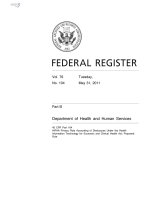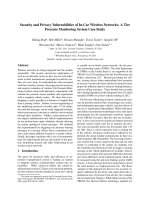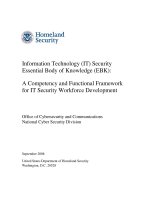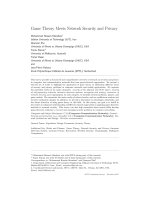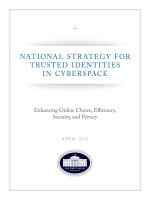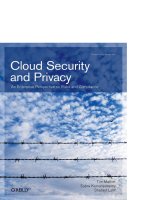POLICY ON INFORMATION TECHNOLOGY MANAGEMENT, SECURITY, AND PRIVACY
Bạn đang xem bản rút gọn của tài liệu. Xem và tải ngay bản đầy đủ của tài liệu tại đây (295.52 KB, 35 trang )
ARKANSAS STATE UNIVERSITY
POLICY ON
INFORMATION TECHNOLOGY
MANAGEMENT, SECURITY, AND
PRIVACY
EFFECTIVE DATE MARCH 4, 2011
This Information Security Manual applies to all personnel,
students, agents, vendors, contractors, and other individuals
or entities utilizing information technology, communications
systems/networks, and data owned or operated by Arkansas
State University.
Table of Contents
Policy Background............................................................................................................
1
Impact Analysis.................................................................................................................
2
Policy Development Process............................................................................................
5
General Policy
........................................................................................................................
6
Information Security Council
........................................................................................................................
8
Electronic Communications Privacy Act
........................................................................................................................
9
Data Protection and Classification
........................................................................................................................
10
Data Access Control
........................................................................................................................
14
Physical Security
........................................................................................................................
16
The Deployment and Use of Wireless Networks
........................................................................................................................
18
The Deployment and Use of Communication Networks
........................................................................................................................
19
Mobile Information Security
........................................................................................................................
20
Incident Reporting and Response
........................................................................................................................
21
Application Development and Management
........................................................................................................................
22
System Security
........................................................................................................................
25
Definitions........................................................................................................................
27
Arkansas State University
Information Technology Management, Security, & Privacy
Policy Background
Information Technology Policies serve a number of purposes for the university
community. These policies further the university's missions, educate the community
about best practices in information technology, promote university-wide operational
efficiencies, and reduce institutional risks. They also guide community members to help
ensure compliance with applicable laws and regulations.
In July of 2009, Arkansas State University engaged a private audit firm to audit the
general security posture of the university in regard to security/privacy policy and
procedure.
The policies set forth are proposed as a result of the findings and
recommendations of the audit firm, at the request of the University System Office to
update technology policies, and at the request of State of Arkansas Legislative Audit.
General Information Technology Policy is often found implicitly in the general policies of
the university as well as in the university's statements and actions. However it is often
helpful to have specific Information Technology Policies formally developed, approved,
maintained and distributed in a consistent and timely manner. This practice helps to
assure the success of university strategic initiatives, compliance with policy objectives,
and establishes the accountability of operating units and individuals affected by each
policy.
Specific Information Technology Policies should have broad applicability throughout the
university. The Chief Information Officer (CIO) is responsible for University Information
Technology Policies. The need for a new policy may become apparent or compelling in a
number of ways. For example, the availability of new technology or changes in the ways
campus community members work could drive the need. Any member of the university
community may contact the Office of the CIO to discuss policy issues, suggest a need
for a new policy, or comment on existing policy.
Specific policies are developed through a broadly based campus-wide consultative
process, and in coordination with university Legal Counsel. Final policies are approved
by the at the campus level by the Executive Council, after which the approved proposals
are provided to the University System Office for Board of Trustee approval.
Once
approved, they are then maintained in the Information Technology Policy Repository.
1
Impact Analysis
For Proposed Policy
Information Technology Security & Privacy
Drafted:
Revised:
14 October 2009
14 May 2010
9 Dec 2010
Responsible Executive(s) (Dean or Vice Chancellor): Vice Chancellor, Finance & Administration
Responsible Office(s): Chief Information Officer
A. Background
1. General Information Technology policy and manual to replace Appropriate Use Policy.
2. Will serve as Board Approved, overarching policy to sanction specific computing and
technology standards outlined in the manual at Arkansas State University.
3. The university must preserve its information technology resources and data, comply
with applicable laws and regulations, and comply with other university policy
regarding protection and preservation of data.
B. Policy Statement
1. ASU expects all individuals using information technology to take appropriate
measures to protect institutional data.
2. Institutional data (information) is either A) an information asset entrusted to the Board
of Trustees or B) an information asset that is the property of the Board of Trustees.
3. Policy statement should read:
“The Board of Trustees of Arkansas State University hereby approves this policy, known
as the “General Policy on Information Security” in an effort to ensure use of owned and
entrusted information resources and data assets, to minimize the liability and risks
associated with these resources and assets, and to establish appropriate information
management environment within Arkansas State University.
Hereby, Arkansas State University expects all information stewards, custodians, and
persons who have access to and/or responsibilities for information resources and data
assets of the institution to manage it according to the rules and policies regarding
storage, disclosure, access, classification, and standards set forth in subsequent
information security policies.
Hereby, Arkansas State University will adhere to the following attached, Information
Technology Management, Security and Privacy Policy”
C. Reason for Policy
1. The security policy will build a framework that guides users and departments in
specific procedures and technologies that address risks.
2. Each section of the manual address specific groups of vulnerabilities and areas of
liability to the university.
3. In order to implement accepted best-practices and improve the financial audit report
of the institution, it is necessary to implement certain policy constructs throughout the
university.
4. Many statutory requirements call for agencies to have Board-approved policies in
place that address areas of vulnerabilities.
D. Overview of Policy Content
2
1. The sections of the manual will each have a “bulletin”. The bulletin will be the
campus-specific information applicable to particular technologies and procedures to
comply with the approved policy.
2. The Information Security Council will periodically recommend updates to technology
bulletins. These updates will be approved by campus executive leadership on each
campus.
3. The General Security Policy establishes the principle that every information
technology device and data element is either an asset or entrusted asset of the
institution (ultimately, the Board of Trustees).
4. The General Security Policy establishes the principle that every data asset aside
from intellectual property is an asset of Arkansas State University and therefore
subject to all security policies.
5. The General Security Policy establishes the principle that intellectual property and
certain personal data are assets not belonging to, but rather entrusted to, Arkansas
State University.
6. The General Security Policy requires all persons and units with access to information
technology and data assets of the University to comply with institutional policy on it
respective handling, treatment, and use.
7. The General Security Policy creates the categories of individuals, each with specific
obligations regarding the security, use, privacy, and handling of information
technology resources and data assets.
E. Consistency with University’s Mission and Goals, Other Policies, and
Related External Documents
1.
2.
3.
4.
5.
Fair and Accurate Credit Transactions Act of 2003
Electronic Communications Privacy Act of 1986
Arkansas Freedom of Information Act
Health Insurance Privacy Policy of 1996
Family Education Rights and Privacy Act
F. Entities, Offices, and Other ASU Community Members Affected By
This Policy
1. All connected persons and assets of Arkansas State University.
2. State all entities that apply:
a. All entities of Arkansas State University
b. All points of delivery and service of Arkansas State University
G. Impact on the University
1. Classification of all institutional data and information.
2. Certain protection mechanisms for data and respective systems and environments,
depending on data classification.
3. Certain network systems will require replacement. This will be accomplished in the
course of regular replacement and renewal.
4. Certain computer systems will require changes in security parameters.
5. Personnel training efforts must be assumed.
6. Certain protection mechanisms surrounding intellectual property and their respective
environments will need to be implemented and/or reconfigured.
7. Acquisition of data security technology. Already underway.
3
H. Stakeholders Who Will Be Consulted in Developing This Policy
1.
2.
3.
4.
5.
6.
7.
8.
9.
Legislative Audit
University Legal Counsel
Executive Counsel
University Business Owners Group
Faculty and Staff Senates
Shared Governance Bodies (as directed by EC)
Academic Dean’s Council
Office of Human Resources
Subject Matter/Industry Experts (as needed)
I. System Changes Required
1. Network authentication from end-to-end. That is, the ability to know “who accesses
what”.
2. Role-based security. That is, rather than location-based security.
3. Some computer systems will require changes to security parameters and operating
constructs.
J. Communications and Training Activities That Will Be Conducted To
Build Awareness and Enable Implementation
1. Faculty, Staff will be required to engage in information security and privacy
awareness training.
2. Regular promotional activities and communication efforts will be implemented to
increase and maintain awareness of information privacy and security matters.
K. Compliance Mechanisms Existing or To Be Created
1. Policy will utilize existing faculty, staff, and student disciplinary procedures and
mechanisms.
L. Timing Requirements for This Policy
1. Some aspects of this policy must be implemented in coordination with the institutional
budgeting process.
2. Policy should be fully implemented by December 2011
4
5
GENERAL POLICY ON
INFORMATION SECURITY
[###.000]
This policy applies to all Faculty, Staff, Students, agents, vendors, contractors, and other
individuals utilizing information technology, communications systems/networks, and data owned,
operated by, or entrusted to Arkansas State University.
A.
Policy Statement on General Information Security
The Board of Trustees of Arkansas State University hereby approves this policy, known as the
“General Policy on Information Security” in an effort to ensure best use of entrusted information
resources and data assets, to minimize the liability and risks associated with these resources and
assets, and to establish an appropriate information management environment within all entities of
Arkansas State University.
Hereby, Arkansas State University expects all information stewards, custodians, and persons who
have access to and/or responsibilities for information resources and data assets of the institution
to manage it according to the rules and policies regarding storage, disclosure, access,
classification, and standards set forth in subsequent information security policies.
Hereby, Arkansas State University will adhere to the following attached, Information Technology
Policies:
1.
2.
3.
4.
5.
6.
7.
8.
9.
10.
11.
12.
Information Security Council Policy [###.001]
Electronic Communications Privacy Act [###.002]
Data Protection and Classification [###.003]
Password Requirements [###.004]
Access Control Policy [###.005]
Physical Security Policy [###.006]
Wireless Security Policy [###.007]
Communications Network Security Policy [###.008]
Mobile Security Policy [###.009]
Incident Reporting & Response Policy [###.010]
Application Development Policy [###.011)
System Security Policy [###.013]
6
B.
Policy Details
In order to manage information technology security comprehensively, this policy serves five major
purposes.
1. It establishes the principle that every information technology device and data element is
either an asset or entrusted asset of the institution, and subsequently under the authority
of the Board of Trustees.
2. It establishes the principle that every data asset aside from intellectual property is an
asset of Arkansas State University and therefore subject to all security policies.
3. It establishes the principle that intellectual property and certain personal data are assets
not belonging to, but rather entrusted to, Arkansas State University.
4. It requires all persons and units with access to information technology and data assets of
the University to comply with institutional policy on its respective handling, treatment, and
use.
5. It creates the categories of individuals, each with specific obligations regarding the
security, use, privacy, and handling of information technology resources and data assets.
The general information security policy establishes the framework for the information security
program. The information security program is comprised of 11 policies, which address specific
areas of vulnerabilities and substantial risk exposure to the institution. The Security Council will
oversee the creation “Policy Bulletins” that will document specific procedures and technologies
used to achieve policy compliance.
Chief Information Officer
Security Council
Employees
C.
Administer and coordinate the overall security policy and program,
which include the following:
1. Propose policy constructs and framework.
2. Draft policy and bulletins.
3. Facilitate Review
4. Manage approval process of necessary and recommended
policy.
5. Promulgate through publishing, educating, and auditing of
policy.
6. Maintain policy in IT policy library.
Acts as advisory body to CIO and IT management through:
1. Advising officers of the institution about issues related to
the security of information, systems, and/or data.
2. Ensure that Information Technology Policy bulletins are
relevant and useful.
3. Recommends policy changes to relevant University policies
on information security.
4. Reviews proposed policy changes.
5. Champions information security program.
Remain aware of, and practice, appropriate handling and use of
technology resources and institutional data through:
1. Following appropriate university procedures and
information security policies.
2. Complete relevant and/or necessary training regarding
information technology and data security.
Responsibilities
7
INFORMATION SECURITY
COUNCIL
[###.001]
A. Members of the Information Security Council
The Information Security Council (ISC) should include Data Stewards and administrative
personnel who are responsible for lines of business within the University.
B. Purpose of the Information Security Council
The purpose of the Information Security Council is to recommend and assist in the
development and maintenance of the information security program at Arkansas State
University.
C. Functions of the Information Security Council
The Information Security Council will serve as the review and recommendation body of the
Information Security Program. The council will be chaired by the CIO or designee. Although
most of the responsibility of creating and maintaining the information security program falls to
the Information Technology leadership, the council has the following primary functions:
1. Review all Information Technology bulletins annually and recommend modification to
executive leadership;
2. Recommend manual modification through executive leadership;
3. Review and approve information reclassification requests under direction of the Data
Stewards.
4. Hold the technology organization accountable for auditing and enforcing information
security policy.
5. Sponsor/conduct relevant user education and information initiative regarding information
security.
6. Champion and sponsor the information security program within each organizational entity.
7. Sponsor and review the annual audit of policies conducted by the information technology
organization.
8. Provide accountability for the Information Technology organization in managing and
administering the information security program.
D. ISC Bulletin
ASU will establish an Information Security Council Bulletin. The ISC Bulletin will be
updated annually in the regular committee appointment process. The bulletin will:
1. Identify ISC members by title and position.
2. Establish regular meeting schedule.
3. Outline critical success factors for the committee.
E. Reporting
The Information Security Council will produce an annual summary of committee
activities and report this information to Executive Council.
8
ELECTRONIC
COMMUNICATIONS
PRIVACY ACT
[###.002]
A. Application of the Electronic Communications Privacy Act
The Electronic Communications Privacy Act applies to any transfer of signs, signals, writing,
images, sounds, data or intelligence of any nature transmitted in whole or in part by a wire, radio,
electromagnet, photo electronic or photo optical system. All electronic communications sent or
received on Arkansas State University equipment or through Arkansas State University
technology systems are presumed to be controlled by the Electronic Communications Privacy
Acti.
B. Interception of Electronic Communications
As the entity providing electronic communications service, Arkansas State University has the
authority to intercept electronic communications without the consent of the person sending or
receiving the communication to ensure compliance with federal and state laws or university
policy. Arkansas State University will not engage in random monitoring except for mechanical or
service quality control checks.
C. Disclosure of Stored Electronic Communications
As the entity providing electronic communication services, Arkansas State University has the
authority to read and disclose the contents of stored electronic communications without the
consent of the person sending or receiving the communication. State Freedom of Information Act
requests may require the disclosure of electronic communications without the consent of the
person sending or receiving the communication. All Freedom of Information Act requests are
required to be forwarded to University Counsel before any records are disclosed.
D. No Expectation of Privacy in Electronic Communications
Because all electronic communications maintained in public offices, or by public employees within
the scope of their employment, are presumed to be public records under Arkansas law ii, no
person utilizing Arkansas State University equipment to send or receive electronic
communications has an expectation of privacy in those communications. Public records include
electronic communications which constitute a record of the performance or lack of performance of
official functions which are or should be carried out by a public official or employee, a
governmental agency, or any other agency wholly or partially supported by public funds or
expending public funds.
9
DATA PROTECTION and
CLASSIFICATION
[###.003]
A. DATA CLASSIFICATION
Data Stewards will assign each data element under their purview to one of three categories:
Public, Limited Access, or Restricted. Data stewards will then be responsible for reviewing
these data classifications as required and recommending classification changes to the
Information Security Council.
This manual defines information as an asset belonging to, or entrusted to, Arkansas State
University. The manual addresses the areas of data classification, data labeling, data
storage, and data retention.
By default, all institutional data not specifically classified in this manual as Restricted Data will
be designated as Limited Access data for use in the conduct of university business or to
satisfy external reporting requirements.
B. Public Data
Public data is information available to the general public.
Examples: High-level Enrollment Statistics, Course Catalog, Current Funds Budget,
Financial Statements, and data on web sites intended for the general public.
C. Limited Access Data
Limited Access data is available internally but is not available to the general public unless
required to be disclosed by law. Users must obtain specific authorization to access limited
access data since the data's unauthorized disclosure, alteration, or destruction may cause
damage to the university, students, faculty, affiliates, or staff.
Examples: Date of Birth, Ethnicity, and Purchasing Data
D. Restricted Data
Restricted data is for internal use only and is never available to the public unless by court
action or consent. Where required, data stewards may identify institutional data elements as
restricted, for which the highest levels of protection should apply, both internally and
externally, due to the risk or harm that may result from disclosure or inappropriate use. This
includes information protected by law or regulation whose improper use or disclosure could:
1.
2.
3.
4.
5.
Adversely affect the ability of the university to accomplish its mission.
Pose a potential threat to the health and/or safety of faculty, staff, students, and
constituents of the institution.
Lead to the possibility of identity theft by release of personally identifiable information
of university constituents.
Place the university into a state of non-compliance with state and federal regulations.
Place the university into a state of non-compliance with contractual obligations such
as payment card industry data security standards.
10
Restricted Data Declaration
The following data are classified as “Restricted”:
1.
2.
3.
4.
5.
Social Security Number of any employee, student, or constituent of the
institution.
Banking and Financial information of any employee, student, or constituent of
the institution.
Academic history and earned grade information of any student/former student
of the institution.
Medical and health information of any employee, student, or constituent of the
institution.
System and Network Configuration, Log Files, and security breach attempts of
any system with authorized access to an ASU network.
Statement on Classification of All Other Data
All other data will be classified as Limited Access Data and University employees will
have access to these data for use in the conduct of university business on a need-toknow basis. These data, while available within the university, are not designated as
open to the general public unless otherwise required by law.
The specification of data as protected should include reference to the legal or externally
imposed constraint that requires this restriction, the categories of users typically given
access to the data, and under what conditions or restrictions access is typically given.
Data stewards are responsible for identifying and requesting safeguards for data. If the
applicable laws and regulations or the General Security Manual does not specify how to
adequately safeguard the restricted data, the Data Steward is responsible for requesting
appropriate safeguards in cooperation with the Office of the CIO and Legal Affairs. In some
cases, multiple data stewards may collect and maintain the same restricted data element.
In these cases, these data stewards and the technology organization must work together to
implement a common set of safeguards. The Information Security Council should review
these safeguards annually.
Data stewards are responsible for communicating and providing education on the required
minimum safeguards for protected data to authorized end users and data custodians.
Examples: Social Security Numbers, Personal Financial Data protected by GLBA, Credit
Card Information protected by contractual obligations under PCI standards, security data,
and any data exempt from disclosure under Arkansas statutes pertaining to public records
unless the exemption is waived by the university.
E. Data Classification Bulletin
A Data Classification Bulletin will be maintained by the university, reviewed, and updated
annually by the Information Security Council. All data belonging to the institution will be
identified and classified in the Data Classification Bulletin.
The Data Stewards are designated in the Data Classification Bulletin along with the data
elements assigned to each Data Steward according in the Data Classification Bulletin. The
Data Steward should be the functional business owner or intellectual property creator within
the entity who assumes responsibility for owned or entrusted data elements. The Data
Steward must approve release of non-public data.
11
Data Stewards may assign non-default Public or Restricted classifications to data based on
the needs of the university as well as applicable laws and regulations. The Data Steward will
bring these classification recommendations to the Information Security Council.
F. Records Retention Bulletin
The university will maintain a Records Retention Bulletin.
The Information Security Council of each entity will annually review the Records Retention
Bulletin and recommend changes, additions, or modifications. The Records Retention
Bulletin will define for each data element:
1.
2.
3.
4.
5.
6.
Data Classification.
Data Storage Location for onsite and offsite storage.
Data Retention Period.
Data Disposal Method.
Data Steward
Responsible Executive
G. Data Storage
All data will be stored according to its classification, meeting the following minimum
requirements:
1.
2.
3.
4.
All data classified as Public Data may be stored de-centrally.
There are no authentication requirements for Public Data access.
A clear source of record should be identified in the Data Classification Bulletin.
All data classified as Limited Access Data must be stored centrally in the central data
center with protected storage with high-level encryption.
a. Exceptions to central storage of Limited Access Data are extended to:
i. Those data identified as Intellectual Property
ii. Academic course work of students.
5. All data classified as Restricted Data must be stored centrally in the central data center
and must remain fully encrypted in transit and at rest.
a. Access to such data must be fully authenticated.
H. Intellectual Property
Intellectual Property is that data which is created in support of the teaching and research
activities of the institution.
A. Intellectual Property that is partially or wholly funded by external sources is by default
labeled as Limited Access data and subject to this manual.
B. Any intellectual property containing data that is classified by the Data Classification
Manual as “Restricted” assumes Restricted status whether or not external funding
applies.
C. Intellectual Property that does not meet the Restricted Use definition is classified as
Limited Use data.
In the event that this policy conflicts with the Arkansas State University Policy on Intellectual
Policy, the Policy on Intellectual Policy will prevail except for the reclassification of any data
that is deemed “Restricted Access Data” under the conditions in this policy.
12
I. Disclosure and Release
It is frequently necessary to share data from various classes of information with agencies,
vendors, or service providers to the University in order to fulfill the mission of the institution.
In such cases where Limited Access Data or Restricted Data is provided, the agency(ies),
vendor(s), or service provider(s) must complete and return a properly-executed NonDisclosure Agreement. The completed Non-Disclosure Agreement will remain on file in the
central data center for the life of the data sharing agreement.
J. Compliance
Any unit or person using, distributing, or accessing any class of data in a manner that does
not appear to be compliant with this manual will be notified by the data steward so that the
use may be brought into compliance. Any access or use posing an immediate threat or risk
to the University or its constituents will be disabled by any technical means possible. Use
remaining non-compliant will be denied access to any University information resource until
the issue is resolved through appropriate university management and disciplinary procedures.
In a perceived emergency situation, the central IT organization may take immediate steps
including fully or partially blocking access, to ensure the integrity and/or confidentiality of
institutional data, to protect the health and safety of the University community members and
property, and/or protect the university from liability.
All decisions, notifications, or measures taken may be appealed to the Office of the CIO. If
resolution or compromise is unable to be reached, the appeal may be referred to the
Information Security Council for final decision.
K. Statement on Physical Security
All institutional data will meet the requirements as outlined in the Statement on Physical
Security.
13
DATA ACCESS CONTROL
[###.004]
A. Access Control
Appropriate access control policies reduce the exposure and risk of all data that belongs to,
or is entrusted to, Arkansas State University. This manual outlines minimum requirements for
data access control.
The Information Security Council will annually review an information access control report to
assure compliance with this manual. This report will be provided by the central IT
organization to the Information Security Council.
Request procedures must take into account the risks associated with the specific data and/or
system being accessed and the need-to-know reason for the request. The following
minimum standards must be incorporated into the individual data access technical policies
and procedures for systems and facilities containing Restricted and Limited Access data:
1. Any person with access to Restricted or Limited Access institutional data shall have
unique and individual user credentials such as a user id and password.
2. Any person with access to Restricted or Limited Access data will use a complex
password of at least 8 alphanumeric characters containing at least one number 0-9 and
one letter A-Z.
3. Access shall be deactivated after a period of inactivity not to exceed 90 days.
4. Access shall be deactivated after 3 failed access attempts, requiring a system
administrator to reset access after identity verification or automatic reactivation after 30
minutes of no access attempts.
5. Terminated employees shall lose access to data as of their termination date.
6. The data access request process for all systems shall be formalized, electronic, and
auditable. The request process must include:
a. Approvals of the requestor’s supervisor.
b. Approval of the Data Steward.
c. Description of the specific data access requested.
d. Level of access requested as read, write, modify or delete.
e. Purpose for accessing the data.
7. Data access requests should be maintained in order to support the need to audit data
access permissions throughout the complete data access lifecycle.
8. An automated monitoring and maintenance process against user authentication must
protect limited Access and Restricted data.
9. Any facility housing systems with Restricted data must meet the following criteria:
a. Two-levels of access control to the site.
b. A method by which the identity of persons entering the site is logged and
archived.
c. A monitoring system to monitor all activity while in the facility.
10. Data access processes, procedures, and authorizations must be reviewed on an annual
basis by each data steward to ensure that access management and control technologies
and procedures are appropriate.
14
III.
Statement on General Account Access
Under various circumstances, access to institutional data may be terminated, but it
remains necessary to leave the general user account in place. Such instances include
courtesy accounts for email access/forwarding, guest accounts for research partners,
retiring employees, technical policy owner accounts, etc….
Under such circumstances, accounts will be assigned to an Account Sponsor. Under
such circumstances, the following applies:
A. The Account Sponsor must be a full-time employee of Arkansas State University.
B. The Account Sponsor is the institutional owner of all data under sponsored account
ownership.
C. The Account Sponsor becomes the owner of the sponsored account.
D. The Account Sponsor is liable for all activity and access by the sponsored account.
E. The Account Sponsor must periodically review activities and information associated
with the account.
F. The sponsored account will have an automated termination date not to exceed 12
months if a renewal request is not received from the Account Sponsor.
V.
Enforcement
A. The central technology organization or respective data steward will notify any unit or
individual determined to be out of compliance with this manual. Efforts should be made
to bring the access control procedures into compliance with this manual. Any access
posing an immediate threat or risk to the university or its constituents will be disabled.
Use remaining non-compliant will be resolved through appropriate university
management procedures.
B. Central IT is responsible for administering and enforcing this manual.
C. All decisions, notifications, or measures taken under this manual should first be appealed
to the central IT organization. If mutual arrangements cannot be made, the decision
should be appealed to the appropriate Vice Chancellor.
15
PHYSICAL SECURITY
[###.005]
Statement Details
Physical control to information reduces the exposure of the institution by controlling
access to hardware, software, networks, and data belonging to, or entrusted to, Arkansas
State University.
A. Minimum Standards for Physical Access to Data
Arkansas State University will maintain appropriate physical access control
procedures that meet the following minimum standards:
1.
Any site containing systems or media within which Limited Access data is
present must have access control in place when unattended. Most
commonly, this will include locked doors.
2.
Any site containing systems or storage media housing Restricted data must
meet the following minimum requirements:
a. Two levels of access control to the site.
b. A method by which the identity of persons entering the site is logged and
archived.
c. A monitoring system to monitor all activity while in the facility.
B. Minimum Standards for Network Access
Arkansas State University will adhere to the following Network Access standards:
1.
2.
3.
4.
5.
The university will maintain a system to control access of devices and
persons to the network. The system must ensure current vulnerability
updates, security releases, and role-based security of the connecting client.
The access control system must authenticate all users at all network entry
points, both terrestrial and wireless.
All facilities containing attached network equipment (routers, switches, etc)
must be single-use, secured (usually via key or card access) facilities.
Access control and traffic logs will be retained for 6 months, and included in
the Records Retention Schedule.
ASU will establish and maintain a network activity monitoring system that
alerts network administrators in the event of unlawful or breach attempt
activity.
16
C. Physical Access Control Bulletin
Arkansas State University will develop and maintain a Physical Access Control
Bulletin. This bulletin will outline the following:
1. Access Control systems that are utilized to achieve manual compliance
and to protect physical access to data, systems, and networks.
2. Names and contact information of individuals responsible for monitoring
and managing the physical layer of information access.
D. Reporting
The IT organization will provide an annual report to its respective Information Security
Council to review physical access-related incidents and follow-up procedures.
17
THE DEPLOYMENT AND
USE OF WIRELESS
NETWORKS
[###.006]
Deployment and use of wireless networks
Wireless networks are layered on all wired networks at Arkansas State University. Any device
utilizing or appropriating wireless access to the University network infrastructure is subject to
the following:
A. All use of wireless access points and devices must comply with applicable laws,
regulations, and university policies including FCC regulations and the university’s
provisions on Acceptable Use.
B. Deployment and use of wireless network access points and devices connected to the
university infrastructure must be registered and approved with the university device
registration & management system at the designated URL.
C. Only centrally managed, university-owned wireless access points may be attached to any
Arkansas State University network.
D. All wireless devices connected to the University network infrastructure must use wireless
spectrums officially recognized by the FCC as production data networks.
E. As with all ASU wired network access, access through wireless access points and
devices must be automatically logged. Logs must be retained for at least 30 days and
should include the identity of the user or equivalent information, the date and time of
access, and the IP address assigned for the session.
F. Any wireless access point and device providing access to data identified as “Restricted”
in the data classification manual must support data encryption of identified data while in
transit and must not retain said data in any manner.
G. Any wireless access point or device must utilize IP address space as assigned by
network management via static or dynamic address assignment.
Enforcement
The central IT organization will notify personnel operating a wireless access point or
device that does not appear to be compliant with this manual so that it may be removed
from the network. Wireless access points not brought into compliance will be denied
network access.
In a perceived emergency situation, the central IT organization may take immediate
steps, including denial of access, to ensure the integrity of the university data network
and systems, safeguard the health and safety of the university community members and
property, or protect the university from liability.
18
DEPLOYMENT AND USE
OF COMMUNICATION
NETWORKS
[###.007]
A. Deployment and use of Communications Networks
Data communications networks support the operations and the health/human safety of all
constituents. To ensure the optimal and reliable operation of this critical university resource,
all communication networks are subject to the following:
1. Use of any network facility must be consistent with the provisions on Acceptable Use.
2. ASU will develop a Network Operating Requirements Bulletin. The bulletin will outline
communications protocols supported by ASU, operational and security requirements that
exceed the minimum requirements of this manual, and device standards for networkattached devices.
3. ASU will maintain, at minimum, a neutral network (commonly referred to as a DMZ), an
academic network, a residential network, and a restricted network.
4. Systems and servers hosting or processing data classified as “Restricted” will be
configured to reside in a Restricted Network on the local area network.
5. All network-attached devices will be registered (by MAC-level address) and authenticated
before being granted network access.
6. Technical, operational, security guidelines and standards will be available in the Network
Operating Requirements Bulletin. All units and personnel using any network resource as
well as devices connected directly or indirectly to wired and wireless networks must
comply with the requirements of the bulletin.
7. Network address space, domain naming spaces, network connections, and video
services will be maintained and managed by the central IT organization.
8. The central IT organization will collaboratively (with the ISC) update the Network
Operating Requirements Bulletin to continually meet changing requirements.
9. To appropriately manage traffic to local, state, and global networks, all network access
and traffic must be authenticated and logged. Log files will be retained for a minimum of
180 days.
10. All units, personnel, students, and connected users will be notified that normal operation
and maintenance of the network requires the central IT organization to routinely engage
in backup and caching, logging activities, and monitoring of usage patterns, and security
activities. However, use of information gathered in this manner is subject to the
university’s provisions on Acceptable Use.
11. The central IT organization will work with all units to ensure use and compliance with this
policy and with the operating requirements. In the event of a conflict, central IT will work
to negotiate acceptable arrangements. If a resolution cannot be reached, the CIO will
specify a resolution to be approved by executive leadership.
12. The Deployment and Use of Communications Networks will be audited annually by
central IT, results of which will be reviewed by the Information Security Council.
I.
Responsibilities
Central IT
Information Security
Council
Manage daily operations of local and wide-area networks.
Ensure performance and service expectations are met. Audit
network performance/security, provide summary report to ISC.
Conduct annual capacity/use analysis, provide summary report
to ISC.
Review compliance summary report. Review traffic and capacity
management plan.
19
MOBILE INFORMATION
SECURITY
[###.008]
Mobile Information Security
Any device connecting to a university network or accessing/storing university-owned
Restricted or Limited Use data is subject to the following provisions:
1. University-owned Devices
ASU will maintain minimum security standards of mobile computing devices that are not
cellular phones, to include:
a. Fully encrypted internal storage use whole-disk encryption.
b. Asset tracking & recovery capability.
c. Password protecting for access. A minimum password length of no less than 8
characters.
2. University-owned Cellular Phones
All university owned cellular phones must:
a. Be procured through the central IT organization.
b. Be registered in the institutional asset management system.
c. Be capable of being remotely disabled or “wiped”.
3. Personally-owned Devices
a. The device must be password protected at all times, with a password length of no
less than 8 characters.
b. The device must support data encryption.
c. Any university data stored on the device must remain encrypted.
4. All Mobile Devices
a. No Restricted data may be stored on the device unless it is encrypted and prior
approval has been obtained from the Data Steward.
b. No mobile computing device may connect to terrestrial or wireless networks without
authentication and scanning for vulnerabilities.
c. By connecting personally-owned mobile devices to the Arkansas State University
network, and/or by storing university-owned information on personally-owned mobile
devices, the user of said device recognizes that the data is subject to all provisions of
this manual and consents to allow Arkansas State University to remotely erase
devise in the instance of terminated employment or device loss.
d. The owner of a personally owned device that has stored university-owned Limited
Use or Restricted data consents to liability for protection of stored data.
In the event that the device cannot be brought into compliance, Limited Use or Restricted
data belonging to Arkansas State University will be removed by necessary steps to
protect the interest of the University or its constituents.
20
INCIDENT REPORTING
AND RESPONSE
[###.009]
A. Incident Reporting
Information security incidents shall be reported to the security address with the central IT
organization utilizing the Security Incident Report.
B. Incident Response
Upon receipt of a Security Incident Report, the central IT organization shall conduct an
investigation and ensure that in all incidents:
1. Are documented and thoroughly and expertly investigated;
2. Are handled in a consistent manner and in accordance with data disclosure notification
laws.
3. That evidence is preserved so as not to corrupt forensic efforts;
4. That harmful effects are mitigated; and
5. That measures to prevent recurrence are identified and implemented.
6. To avoid inadvertent violations of state or federal law, neither individuals nor departments
may release University information, electronic devices or electronic media to any outside
entity, including law enforcement organizations, before making the notifications required
by this manual.
C. Incident Reporting Bulletin
ASU will develop an Incident Reporting Bulletin on how its respective constituents should
report information security incidents.
ASU will prepare an annual incident summary report to be reviewed by the Information
Security Council.
21

